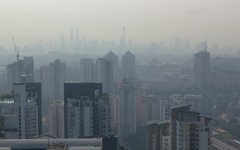Urbanization, Environmental Issues
 It is clear that the world is becoming more
It is clear that the world is becoming more
and more urban. It has been predicted that by the year 2050, 70% of the human population on Earth will live in cities¹. There are many environmental problems that are associated with so much urbanization on the landscape. These are issues that humanity is going to have to find solutions to if we are to both dwell in cities, yet have a livable planet for future generations.
- Heavy natural resource use
- The loss of natural ecosystems
Cities can be large sources of air pollution, water pollution, land pollution, and soil pollution, waste that is littering the landscape, and are also often associated with challenging issues of sanitation that can lead to the pollution of land and water.
Cities are a large source of waste. This waste must be managed somehow, and can end up polluting the landscape and waterways. Industrial and toxic waste that is produced in cities can lead to large amounts of pollution of the urban landscape, causing many environmental and human health issues.
Cities contain large amounts of impervious surfaces that do not allow water to infiltrate the ground. Much of the rainwater that does fall on the urban landscape quickly runs off into rivers and streams, bringing all of the pollutants and chemicals that were present on these surfaces with them into waterways.
With increased urbanization, there is a lot more light that shines at night. There are studies that indicate that all of the human-produced light at night is disrupting the natural biological rhythms of organisms that have evolved within a dependable natural night and daylight cycle. This can impact not only diurnal species, but also nocturnal species that greatly depend on it being naturally dark at nighttime².
With increased global urbanization, there is also an increased level of noise, both in volume and in consistency that humans and other organisms are constantly exposed to. Because wildlife are highly dependent on sound, they can become disoriented and their behavior and communication abilities can be hampered due to the excessive noise levels that they are exposed to in and around urban areas³.
- Fragmentation of habitat and isolation of wildlife and plant populations
- An increase in human-wildlife conflicts




